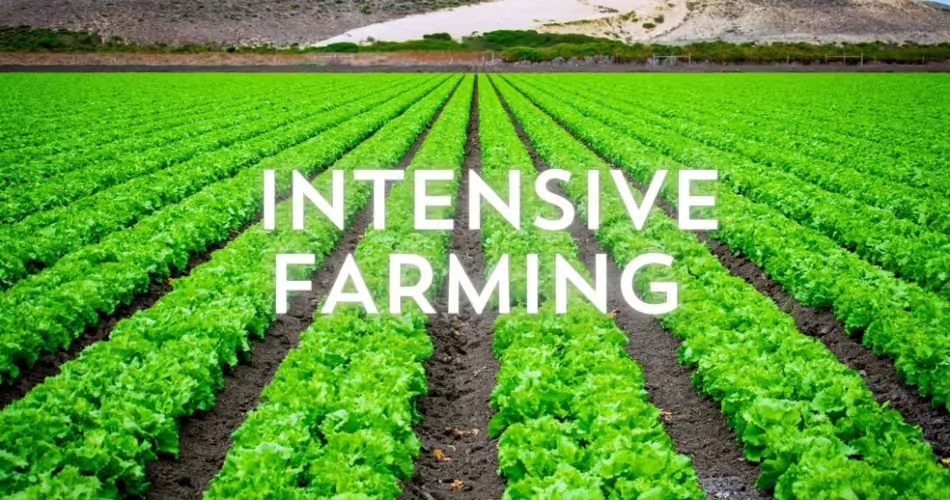This blog will help you understand the concept of intensive farming. Firstly it will explain what is Farming and the Types of Farming. Secondly, it will elaborate what is Intensive Farming and Example of Intensive Farming. Then we will discuss Methodologies of Intensive Farming along with their Solutions. In the end, we will highlight the Advantages and Disadvantages of Intensive Farming.
1: What is Farming?
Farming is an act or process of working on the ground, planting seeds, and growing edible plants. You can also define this as raising animals for milk or meat. Farming is a great way to describe the lifestyle and work of people whose jobs are in agriculture. The planting that is not related to food will be called as agriculture.
2: Types of Farming:
Following are some of the types of Farming:
• Arable Farming:
It is the process of growing crops with traditional methods in open farms. It is farming of common crops such as soy beans, corn, rice etc.
• Livestock Farming:
It is the process of raising animals for meat, milk, eggs wool and other resources. This is the source of dairy products and other animal driven goods.
• Silvopasture:
It is the method of integrating trees, crops and livestock on the same land. It is a multi-layered production system, that provides benefits to three different resources at the same land.
• Organic Farming:
This methods avoids the synthetic fertilizers, pesticides and genetically modified organisms GMOs so it prefers using the natural crop rotation, biological pest control and compost.
• Intensive Farming:
It is the farming that promotes maximum growth of edible crops such as rice, wheat, corn etc. This is the step to fight against food insecurity.
• Extensive Farming:
It is the farming that is done on a large area. We can also call it mechanical farming. It include tillage to maximize the output. Farmers increase the land size to improve yield and cultivation.
• Subsistence Farming:
This is a small scale farming, mostly only for the consumption of the family. The crops produces as a result of subsistence farming have very little sales or no sales.
• Vertical Farming:
It is the latest method of farming that allows you to grow crops in vertical manner with the help of stacks. This is an effective method of farming in bulk on a small area. E.g. Aeroponics and Hydroponics etc.
• Aquaponics:
It is the method of combining aquaculture and hydroponics. In this method the fish wastes provides nutrients for plant growth so plants are grown within the water.
• Urban Farming:
It is the part of green development, in this farming is done within the city. We grow crops in this type, in the form of kitchen gardens, green roofs, community gardens and vertical farming.
These are some of the types of Farming.

3: What is Intensive Farming?
It is a method of agriculture production that requires a lot of input to maximize productivity.
• In this activity advance agriculture techniques are used to increase the yield. Small area and expensive techniques are used due to remote development areas.
• We can also use this for the raising of livestock of animals like cows, chicken etc. being held indoors. Due to increase in population government of different countries take a decision of doing intensive farming in urban areas so that people gets their products quickly.
• The vegetables and products are quickly available in markets and transportation cost is very friendly. Intensive farming kills beneficial insects, and plants also depleted the soil.
• Intensive Farming helps us in meeting the needs of food required for the population. But unfortunately the methods that in intensive farming are harming our environment at a great extent. We should alter the ways of intensive farming or choose sustainable ways of farming to avoid further damage to the environment.
“According to WWF farming practices, livestock and clearing land for agriculture increase Green House Gases (GHGs) in the atmosphere which cause temperature to rise. “
Examples of Intensive Farming:
By using high quality fertilizers and pesticides the concentration of Nitrogen and Phosphorus has increase. Although they good for the plant growth but the massive use of these chemicals effects the environment badly. 20% of the nitrogen and phosphorus are washed by streams and lakes rest of the 80% directly enter into the atmosphere.
In Japan and India region Kerala, west Bengal, Tamil farmers provide wet paddy culture for the crops to grow. Poor land available for the cultivation of crops. Due to intensive cultivation the land available for the farming is limited because of high quality chemicals. It is also responsible for 80% of tropical deforestation. Also the farmers gets burden.
“We abuse land because we regard it as a commodity belonging to us. When we see land as a community to which we belong, we may begin to use it with love and respect.”
3: Methodology of Intensive Farming:
Following are the methodologies for Intensive Farming:
1. Over Grazing:
The intensive animal consumption of plants, which extracts an unsustainable yield of floral biomass from an ecosystem, typically occurring over an extended period of time and without a sufficient recovery period. Over grazing may take the nutrients away from the land and act as severe erosion in many cases. We should change the locations of grazing for animals after a period of time because it is very damaging for the land.
Solutions for Overgrazing:
1: Shifting livestock to other feeding ways.
2. Mono-culture:
The practice of growing one type of crop intensively over a large area, is at the core of industrial food production so the chosen crop, most commonly corn, wheat, soybeans, cotton or rice, is typically replanted in the same soil area year after year with no introduction of a different crops, which creates a system with very little diversity and same types of nutrients. This cause the deficiency of same types of nutrients in the soil and eventually the required nutrient is eliminated.
Solution for Mono-culture:
3. Irrigation:
Artificial application of water to the land for various purposes, such as growing crops, maintaining landscapes and for use in dry areas and during periods of inadequate rainfall. (By canals, tube wells etc.) Many traditional ways of irrigation cause a lot of water wastage and lead to water scarcity. We should take preventive measures and use efficient methods to avoid water wastage. Efficient methods will allow us to conserve water as well as provide to the farms in proper way.
Solution for Irrigation:
2: Irrigation Scheduling
3: Compost and Mulch
4. Slash and Burn:
It involves the cutting and burning of forests or woodlands to create fields. It is primarily associated with rain forests and used by tribal communities for subsistence farming. The cleared area, known as Sweden, is used for a relatively short period of time and then farmers leave them alone to return to a more natural state. It is not a right decision to make a forest an agricultural land because forests takes hundred of years to grow and bloom properly.
Solution for Slash and Burn:
1: Reclamation of land by Reforestation
2: Abandonment
“Every day, nearly 16,000 children die from a hunger-related cause — 1 child every 5 seconds. People are hungry because the “global food system” we have built is out of control — it prioritizes historically unprecedented corporate profits, while failing to feed people and steward our land and water resources for future generation”
We cannot stop the applications or methodology of Intensive farming but by knowing Advantages and Disadvantages, we can manage its use.
4: Advantages and Disadvantages of Intensive Farming:
Advantages of Intensive Farming:
Following are some advantages of Intensive Farming:
One of the major advantage of this technique is that, the crop yield is high.
It helps the farmer to easily supervise and monitor the land and protect his livestock from injuries or death by dangerous animals.
With the introduction of intensive farming the farm products are easily available in markets, in a large quantity.
It allows space and other requirements for farming to be less and more economic.
Disadvantages of Intensive Farming:
Following are some disadvantages of Intensive Farming:
Intensive Farming involves the use of various kinds of chemicals, pesticides and herbicides
It can lead to overcrowding due to the fact that large amount of the animals are living in small areas and facilitates diseases and infections
The use of chemicals and fertilizers contaminate the soil and water bodies
- Intensive practices can cause soil erosion because of the damaged topsoil.
Conclusion:
Intensive farming is essential to fulfill the needs of food for growing world population. It provide us increased yield of crops and help us to grow crops enough for the consumers. We should take out better alternatives and continue intensive farming sustainably by avoiding any environmental damage and deficiency of food supply. It will fulfill our needs as well as protect and conserve the environment. We can turn to useful and suitable methods of farming such as aquaculture, vertical farming and Hydroponics to avoid damage to the environment. As intensive farming cannot be stopped, so we should try to reduce it and shift to sustainable methods of farming to meet the needs of the food for existing population. We should be serious about the environmental damage that intensive farming is causing every year. We have discussed the Advantages, Disadvantages and Methodology of Intensive Farming in this blog.

To learn about more topics, click the link below:
Population Growth and Land use change


Comments